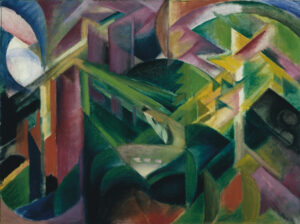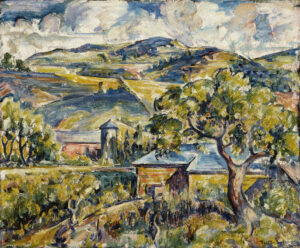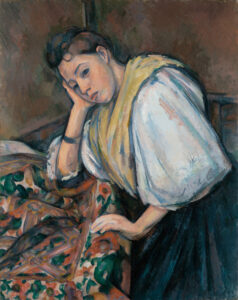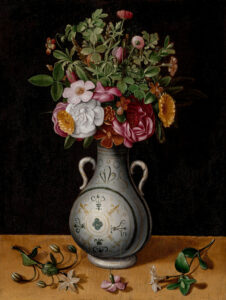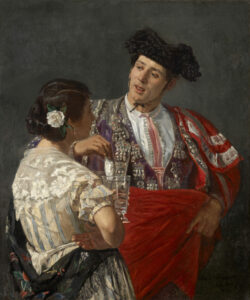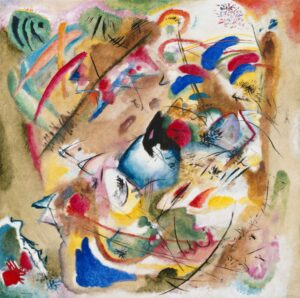
Bertrand Jean Redon, known as Odilon Redon, was born on April 20, 1840, in Bordeaux, France, to a prosperous family. His father, Bertrand Redon, and his mother Odile—a young Creole of French origin born in New Orleans—came to France after the birth of Odilon’s older brother Ernest. The marriage had taken place in the United States when Odile was merely fourteen years old.
Odilon Redon’s biography
Of delicate health, young Redon suffered from epilepsy from the age of four, leading his parents to entrust him to a nurse and later to his uncle in the countryside. His childhood was divided between Bordeaux and the family estate of Peyrelebade near Listrac-Médoc, a vineyard property purchased by his father. It was in this landscape characterized by chiaroscuro that his first charcoal drawings emerged, foreshadowing the strange, phantasmagorical universe that would come to define his oeuvre. In 1846, following a pilgrimage to the Basilica of Notre-Dame de Verdelais, the child experienced a healing that his family regarded as miraculous.
At seven, a visit to Parisian museums profoundly impacted his artistic sensibility. Back in Bordeaux, he received a classical education supplemented with violin and piano lessons, earning a drawing prize at age eleven. From 1855, he took drawing and watercolor lessons with Stanislas Gorin, a pupil of Eugène Isabey, who introduced him to the works of Millet, Corot, and Gustave Moreau.
Yielding to paternal pressure, Redon undertook architectural studies in Paris in 1857 but failed the École des Beaux-Arts entrance examination in 1862. Between Paris and Bordeaux, he developed his intellectual and artistic sensibilities. In Bordeaux, his meeting with the botanist Armand Clavaud proved decisive: Clavaud initiated him into natural sciences and literature, introducing him to Darwin, Lamarck, Pasteur, Baudelaire, Flaubert, Edgar Allan Poe, and Hindu poetry.
In Paris, he briefly joined Jean-Léon Gérôme’s studio, but the relationship between master and pupil proved difficult. Back in Bordeaux, the artist formed a bond with Rodolphe Bresdin, who taught him engraving. Under his guidance, Redon created his first series of etchings, Le Gué (The Ford), printed in 1866, reflecting an Orientalist and Romantic inspiration inherited from Delacroix.
The “Noirs” and Exploration of the Imaginary (1870-1890)
During the Franco-Prussian War of 1870, Redon served as a common soldier in the battles along the Loire. After the conflict, he settled in Montparnasse while regularly returning to Peyrelebade during summers and to Brittany in autumn. He frequented Madame de Rayssac’s literary and musical salon, where he met Fantin-Latour, Paul Chenavard, and the composer Ernest Chausson. These years saw Redon deepening his art through contact with nature, particularly during his stays in Barbizon where he studied trees and undergrowth.
The year 1879 marked a turning point in his career with the publication of his first album of lithographs, Dans le rêve (In the Dream). This series of ten plates printed by the Parisian printer Lemercier revealed his personal universe, dedicated to exploring the imagination and the depths of the unconscious. Fantin-Latour taught him the use of the grease pencil, a technique that allowed him to render on lithographic stone the intensity of blacks characteristic of his charcoal drawings.
On May 1, 1880, he married Camille Falte in Paris, a native of Bourbon Island (now Réunion), who would play an essential role in his life by providing stability and daily support. In 1884, the publication of À rebours (Against Nature) by Joris-Karl Huysmans, which devoted a laudatory passage to Redon, contributed to his recognition in Symbolist literary circles.
During this period, Redon developed what he would call his “noirs“—charcoal drawings and lithographs with dreamlike subjects. Series such as À Edgar Poe (To Edgar Poe, 1882), Les Origines (The Origins, 1883), Hommage à Goya (Homage to Goya, 1885), and La Tentation de saint Antoine (The Temptation of Saint Anthony, 1888) revealed a world populated with hybrid beings, fantastic creatures, and nightmarish visions that seemed to emerge from the depths of the unconscious.
His fascination with science, nurtured by his friendship with the botanist Clavaud, is reflected in works where he explores evolutionary theories, microscopic observations, and natural forms. The eye, a symbol of perfection for creationists but also an organ of perception and knowledge, became a recurring motif in his iconography, notably in L’œil comme un ballon bizarre, se dirige vers l’infini (The Eye Like a Strange Balloon Mounts Toward Infinity).
Toward Light and Color (1890-1916)
Redon’s life underwent several major upheavals around 1890: the death of his first son Jean in 1886, just months after his birth; the passing of his friend Armand Clavaud; and the loss of the family estate at Peyrelebade, to which he was deeply attached. These personal tragedies were compounded by health problems that triggered a profound spiritual crisis in the artist.
This difficult period coincided with a radical transformation of his art. From 1890 onwards, Redon gradually abandoned his “noirs” to turn to pastel and oil. The birth of his second son, Arï, in 1889, symbolically marked this artistic rebirth. “I have married color since,” he would later write to Maurice Fabre. “I tried to make a charcoal drawing as before, impossible; it was a break with charcoal.”
In 1899, Maurice Denis introduced him to the Nabis group and painted him in 1900 in L’Hommage à Cézanne (Homage to Cézanne). This new phase of his career was characterized by a vibrant palette and more serene subjects, dominated by flowers, portraits, and mystical evocations. Works such as Les Yeux clos (The Closed Eyes, 1890), La Barque mystique (The Mystical Boat, 1900), and Le Char d’Apollon (Apollo’s Chariot, 1905) attest to this evolution toward a more serene and luminous expression.
This evolution also reflected a profound spiritual change. Redon adopted an anti-materialist Christian ideal, tinged with utopian socialism and influenced by Buddhist wisdom. His painting became the vehicle for a quest for transcendence and harmony, where color now expressed spiritual emotions rather than existential anxieties.
The 1900s saw the artist’s consecration. In 1900, he collaborated with Mallarmé and exhibited at the Durand-Ruel gallery. In 1904, an entire room at the Salon d’Automne was devoted to him, presenting sixty-two works. The Legion of Honor crowned his career. The year 1913 marked his introduction to the American continent with the exhibition of forty of his works at the Armory Show in New York.
Between 1900 and 1914, Redon created several large painted decorations: for the Château de Domecy-sur-le-Vault in Burgundy, composer Ernest Chausson’s private mansion in Paris, and Fontfroide Abbey near Narbonne. This last commission, executed between 1910 and 1911 for his friend and patron Gustave Fayet, constitutes a veritable artistic testament with its two large panels, Le Jour (The Day) and La Nuit (The Night), which synthesize the two periods of his creation.
Odilon Redon died on July 6, 1916, at his Parisian home at 129 Avenue de Wagram, leaving an unfinished oil painting, La Vierge (The Virgin), on his easel. He was buried in the small cemetery of Bièvres, where he had spent his last summers.
The Work and Legacy
Redon’s oeuvre is characterized by a fundamental duality that reflects the evolution of his life: on one hand, the “noirs” of his first period (1870-1895), explorations of the depths of the unconscious and existential anxieties; on the other, the colorful compositions of his maturity, mystical celebrations of light and harmony.
His graphic production comprises twenty-seven etchings, three dry points, and one hundred ninety-seven lithographs. Among his most important albums are Dans le rêve (1879), À Edgar Poe (1882), Les Origines (1883), Hommage à Goya (1885), La Nuit (1886), and La Tentation de saint Antoine (1888, 1889). His painting evolved from dark charcoals to oils and pastels of intense luminosity, populated with imaginary flowers, mythological figures, and dreamlike visions.
Several major influences nourished his art: music, particularly that of Schumann, whom he considered “the god of his youth”; science, through the evolutionary theories of Darwin and Lamarck, microscopic discoveries, and the study of botany; and finally, spirituality, which he initially approached through the prism of Catholicism before exploring other traditions such as Buddhism.
A precursor of Symbolism, Redon developed a unique visual language where form serves emotion and inner expression. As he himself wrote: “My drawings inspire and do not define themselves. They determine nothing. They place us, like music, in the ambiguous realm of the undetermined.”
His influence on modern art is considerable. The Surrealists recognized in him a forerunner in the exploration of the unconscious. His conception of color as a vector of emotions rather than a representation of reality anticipates the research of the Expressionists and the Fauves. Finally, his ability to navigate between figuration and abstraction, to suggest rather than describe, makes him a resolutely modern artist whose approach still resonates today.
Long considered a marginal artist, Redon now occupies an essential place in the history of 19th-century art, as evidenced by the major retrospective dedicated to him in 2011 at the Galeries nationales du Grand Palais in Paris and the Musée Fabre in Montpellier, the first major French exhibition on the artist since 1956.
Chronology
- 1840: Born in Bordeaux on April 20
- 1846: Recovery from epilepsy following a pilgrimage to Verdelais
- 1855: Begins drawing lessons with Stanislas Gorin
- 1857: Sent to Paris for architectural studies
- 1862: Fails the École des Beaux-Arts entrance examination
- 1866: First series of etchings, Le Gué
- 1870: Serves as a soldier in the Franco-Prussian War
- 1879: First lithographic album, Dans le rêve
- 1880: Marries Camille Falte
- 1884: Laudatory mention in Huysmans’ À rebours
- 1886: Birth and death of his first son, Jean
- 1889: Birth of his second son, Arï
- 1890: Beginning of his color period
- 1899: Introduced to the Nabis group by Maurice Denis
- 1900: Exhibits at the Durand-Ruel gallery
- 1904: Entire room dedicated to him at the Salon d’Automne
- 1910-1911: Decoration of the library at Fontfroide Abbey
- 1913: Exhibition at the Armory Show in New York
- 1916: Dies in Paris on July 6
Critical Assessment
Redon’s artistic journey represents one of the most striking aesthetic transformations in late 19th-century European art. Initially creating what he termed his “noirs“—somber charcoal drawings and lithographs exploring the subconscious—he later embraced color with extraordinary vibrancy and symbolic power. This dramatic shift from darkness to light paralleled profound personal experiences and spiritual evolution.
His work defies simple categorization, bridging Symbolism and nascent Modernism. While contemporaries like Gustave Moreau employed elaborate iconography, Redon created a more ambiguous visual language that resonated with the Symbolist poets’ quest for suggestion rather than description. His statement that his drawings “place us in the ambiguous realm of the undetermined” aligns with Mallarmé’s poetic philosophy.
The technical aspects of Redon’s art reveal exceptional versatility. His mastery of lithography revolutionized the medium’s expressive potential, while his later pastels and oils display an intuitive understanding of color relationships that anticipated Expressionist innovations. His floral compositions, rather than being mere decorative works, represent profound meditations on color and form, suggesting interior states rather than exterior realities.
Redon’s dual legacy—exploring both darkness and light, conscious and unconscious—established him as a crucial transitional figure between 19th-century Romanticism and 20th-century Modernism. His influence extends from the Surrealists’ exploration of the unconscious to the Abstract Expressionists’ emphasis on art’s emotional and spiritual dimensions. Today, Redon is recognized as a visionary whose work continues to offer insights into the relationship between inner experience and artistic expression.

